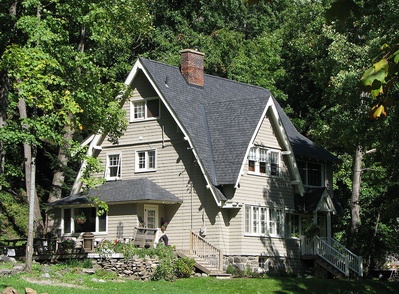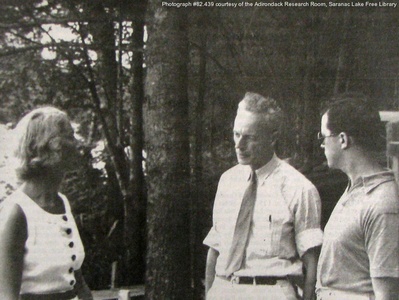 William G. Distin, discussing great camp plans with the Hochschilds of Blue Mountain Lake. Adirondack Daily Enterprise, March 13, 2004
William G. Distin, discussing great camp plans with the Hochschilds of Blue Mountain Lake. Adirondack Daily Enterprise, March 13, 2004 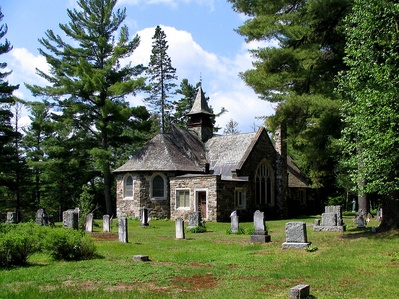 St. John's in the Wilderness Episcopal Church Born: February 25, 1884 1
St. John's in the Wilderness Episcopal Church Born: February 25, 1884 1
Died: March, 1970 2
Married: Ethel Brown Distin
Children: William G. Distin, Jr., Robert Grenville Distin
William George Distin, Sr., an architect of Saranac Lake, was the protege of Great Camp designer William L. Coulter and went on to design a number of Adirondack Great Camps.
Born February 25, 1884, in Montreal, Canada, the son of photographer William L. Distin and Helen Gray Distin, he moved with his family first to Plattsburgh, then to Saranac Lake in 1898. After graduating from Saranac Lake High School in 1901, he was hired by William Coulter as a draftsman; his apprenticeship lasted six or seven years. In 1907, the year that Coulter died, Distin entered Columbia University, graduating in 1910. After a short period in Chicago, working for S. S. Beman designing houses, he traveled for a time in Europe. Returning to Saranac Lake about 1912, he joined the Coulter & Westhoff architectural firm, then run by Max Westhoff, Coulter's former partner. Distin married Ethel Brown of Syracuse on September 1, 1915, and the couple had two sons, Robert Grenville Distin (Sr.) and William George Distin, Jr. In 1917, Distin worked for the Army building hospitals in Washington, DC. After the war, he returned to Saranac Lake to take over the firm, and Westhoff moved to Springfield, Massachusetts.
After some smaller commissions for camps on Upper Saranac Lake, he designed Camp Wonundra for William Rockefeller in 1934. In 1937 he built "Eagle Nest" at Blue Mountain Lake for Walter Hochschild, and in 1948, Camp Minnowbrook, in the same area, for R.M. Hollingshead. There were also seven smaller great camps on Lake Placid, and work on the Lake Placid Club.
Distin also designed a number of notable churches, including rebuilding St. John's in the Wilderness Episcopal Church in Paul Smiths after the original log church was destroyed by fire; designing the second St. Bernard's Catholic Church in Saranac Lake with Max Westhoff; redesigning St. Eustace Episcopal Church in Lake Placid for its move to Main Street; and designing the Island Chapel, on Upper Saranac Lake. He also designed the replacement of the original Adirondack Loj, which burned in a catastrophic fire that swept Essex County in 1903.3
Adirondack Daily Enterprise, March 24, 1970
William G. Distin
The funeral service for William G. Distin, who died Saturday evening at his home in Glenwood Estates, Saranac Lake, will be held at 2 p. m. Thursday at the Fortune Funeral Home with the rector of St. Luke's Church, the Rev. Peter Hill, officiating. Cremation will take place in Troy.
Friends may call, beginning at 2 p. m. Wednesday at the funeral home.
Mr. Distin was born Feb. 25, 1884 in Montreal, a son of William L. and Helen Gray Distin. The. family moved to Saranac Lake in 1898 and Mr. Distin later became an architect and designed many local structures. His wife, Ethel Brown Distin, died in 1959.
He was very active in the Saranac Lake Rotary Club and also was a member of the Moose Lodge.
Survivors are two sons, William Jr. of Saranac Lake and Robert of Washington, Conn., and two sisters, Mrs. Herbert R. Leggett, [Helen], and Mrs. Charles Roberson, [Rhoda], of Saranac Lake; four grandchildren and several nieces and nephews.
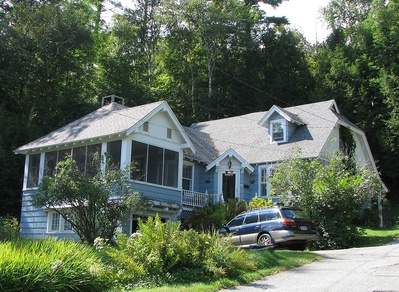 Distin Cottage on Kiwassa Road
Distin Cottage on Kiwassa Road
Mr. Distin's family requests that friends wishing to remember him make contributions to the Saranac Lake General Hospital or to the Saranac Lake Free Library.
Adirondack Daily Enterprise, March 24,1970
THE BUILDER
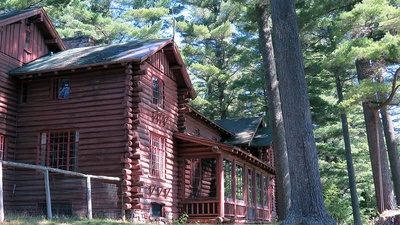 Debar Pond Camp, Duane, New York, 2017William G. Distin, Sr.—it's almost difficult to write the full name since "Bill" Distin seems so much more natural—surely left his mark in the Adirondacks. In fact, hundreds of marks all over the landscape… in schools, and Summer "camps," and libraries and institutions.
Debar Pond Camp, Duane, New York, 2017William G. Distin, Sr.—it's almost difficult to write the full name since "Bill" Distin seems so much more natural—surely left his mark in the Adirondacks. In fact, hundreds of marks all over the landscape… in schools, and Summer "camps," and libraries and institutions.
Architecturally, in terms of the more recent years, we like to think of Bill Distin's legacy as two structures and an incident.
Perhaps the largest structure with which he was connected professionally over the past decade is the Trudeau Institute which must surely be the most beautifully located and designed medical research facility in the nation, looking over the softly majestic sweep of the Lower Lake. And what could be more appropriate than the Trudeau Institute as the architectural legacy of this quiet artist who was born in Canada but lived 72 of his 86 years in Saranac Lake!
The second recent work of Bill Distin we like to associate with him is the new library at the Will Rogers Hospital. Designed by Bill Distin, Sr. and built by Bill, Jr., this is one of the architectural gems of the area, combining, a sense of cathedral-like space and the spirit of the Adirondacks with all the technical advantages of AV, those modern mystical initials meaning audio-visual facilities.
* * *
And then there was the incident. It took place only a few weeks ago, in the Community Room of the Saranac Lake Free Library which was, itself, so close to Bill Distin's heart.
Benjamin Thompson, the North Country Community College architect, until recently head of the Graduate School of Design and Architecture at Harvard and generally recognized as one of the most innovative spirits of his profession, was scheduled to give a presentation of his views to the faculty and interested local citizens.
Just by chance, on display in the Community Room was the beautiful collection of drawings and water colors by Bill Distin and by members of his family. And just by chance, Bill Distin telephoned us several days previously on another matter. We called to his attention the Ben Thompson presentation and arranged to have him called for.
Frankly, we then began to worry about it. Ben Thompson gives a "presentation" with three slides simultaneously shown on three screens and a background of very modern folk music. The purpose is to suggest the relationship between environment and architecture. It is far more "mod" than it is traditional. We began to worry that perhaps Bill Distin, the traditionalist, would be unhappy about what he would see and hear.
Our worries were needless. At the conclusion of Ben Thompson's presentation, Bill Distin rose and asked to make a statement. He expressed, with the simple eloquence that was so characteristic of his speech, his appreciation of what he had seen, his commendation of the college for securing the architectural services of a man of Ben Thompson's imagination, and his complete confidence that the college campus-to-be would be a great asset to the area.
The incident is worth recounting only because it demonstrates that Bill Distin was an artist of his time and period, but also an artist of all times and periods.
* * *
Until the last couple of years, until the miserable fall on the slippery parking lot behind his office, Bill Distin never seemed to be slowing down for reasons of age. We shall always think of him over his drawing board in the little office in the basement of the Main Street building, always ready to give advice on the future of the Adirondacks, and especially of this Village of Saranac Lake.
This was, indeed, his village and he cared for it as, a father cares for his son, planning always for its future, expressing indignation when he felt mistakes were being made, joining in every effort to improve his image and the daily life of its people, rejoicing in its triumphs.
And here were most of his family. Until the last few years his wife, Ethel, shared his joys and sorrows, and his two sisters are here, Mrs. Herbert Leggett and Mrs. Charles Roberson, and Bill Distin, Jr. (who, as these lines are being written, is in Europe and unreachable to learn that his father is no more). Only Bob and his family have moved away and they have returned often to be with him.
Bill Distin lived actively and fully and fruitfully; he died peacefully. The entire community mourns him.
J.L. [James I. Loeb]
Sources
- Gilborn, Craig. Adirondack Camps: Homes Away from Home, 1850-1950. Blue Mountain Lake, NY: Adirondack Museum; Syracuse: Syracuse University Press, 2000.
Comments
Footnotes
1. Social Security Death Index
2. Social Security Death Index
3. This article appeared originally on "Wikipedia" as William G. Distin; its edit history there reflects its authorship. It is licensed under the GDFL.



